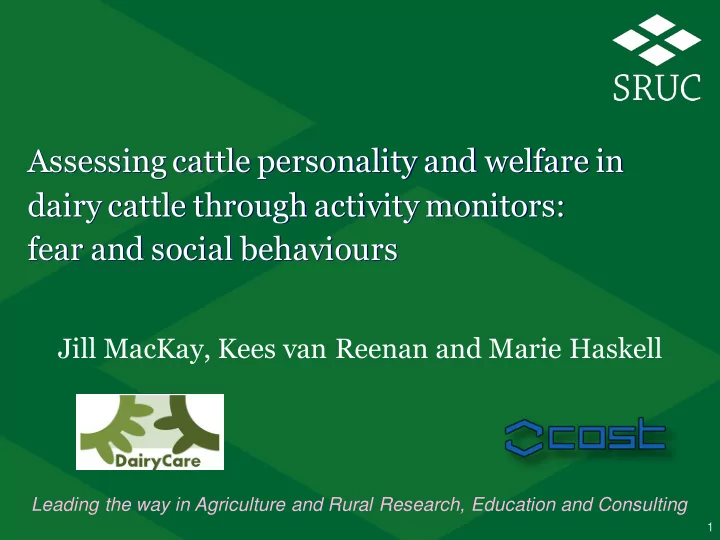

Assessing cattle personality and welfare in dairy cattle through activity monitors: fear and social behaviours Jill MacKay, Kees van Reenan and Marie Haskell Leading the way in Agriculture and Rural Research, Education and Consulting 1
Commercial Activity Recording Systems • Many commercial systems utilise tri-axial accelerometer-based activity monitors • This results in long term continuous recording of activity data • This information is currently primarily used to detect oestrus and increasingly to detect disease • The recordings could be used to tell us more about the cow
Personality/temperament and welfare • What is personality? – A set of responses to stimuli or situations that characterises an individual and is stable over time – e.g. fearfulness, aggressiveness, sociability
Personality/temperament and welfare • How can personality relate to health and welfare? – Individual level: fearful animals more disturbed by new events, take longer to adjust to changes in housing, feeding re-grouping – less sociable or aggressive animals may withdraw from crowded feeding and lying areas. Feed intake and resting may be affected – Farm level: high levels of fear may indicate poor stockhandling
Aim and design • Aim: can we characterise personality traits relevant to welfare using activity monitors? • 1. Characterise sociability • 2. Characterise fearfulness/neophobia • 3. Relate these characteristics to measures from the activity monitors
Wageningen Dairy Research Centre • The Dairy Research Centre in Friesland, the Netherlands, has three herds: 1. MS1. Activity monitors and robotic milkers n = 58 ±3 (sd). 2. MS2. Activity monitors and robotic milkers n = 46 ± 1 (sd) during experimental period. 3. Traditional herd, parlour with no activity monitors.
Methods 1. We recorded the activity of MS1 and MS2 in the 40 days prior to testing. 2. Cows in MS1 and MS2 were then given 2 x temperament tests (fearfulness (NANO) and sociability (SOC)). 3. We created personality dimensions from behaviours exhibited in each test using Principle Components Analyses. 4. We looked for significant associations between personality traits observed in testing and spontaneous home pen activity.
Methods: activity monitors • Standing, lying, no. of steps and MotionIndex ™ (overall activity) calculated. Downloaded at each milking
Methods: fear testing protocol
Methods: sociability testing 2m 5m
Fearfulness test dimensions 1&2 P rinciple components 1 and 2: ‘ neophobia ’ (fear) and ‘vocalisations’ 1 0,8 N Vocalisations 0,6 'Vocalisations' (Y-Axis) 0,4 Latency to N Object Contacts 0,2 N Defecations Contact Object † † Duration Standing 0 -1 -0,8 -0,6 -0,4 -0,2 0 0,2 0,4 0,6 0,8 1 -0,2 N Wall Contacts N Shifts -0,4 -0,6 N Floor Contacts -0,8 -1 'Neophobia' (X-Axis)
Fearfulness test dimensions 1&3 Principle components 1 and 3: ‘ neophobia ’ (fear) and ‘boldness’ 1 0,8 0,6 Duration Standing 'Boldness' (Y-Axis) 0,4 0,2 Latency to Contact N Object Contacts Object † † N Vocalisations 0 -1 -0,8 -0,6 -0,4 -0,2 0 0,2 0,4 0,6 0,8 1 -0,2 N Floor Contacts N Shifts -0,4 N Wall Contacts -0,6 N Defecations -0,8 -1 'Neophobia' (X-Axis)
Sociability test dimensions Principle components 1 and 3: ‘’response to social isolation’ and ‘vocalisations’ 1 0,8 0,6 0,4 0,2 Latency 5m Line Avg N in 2m Box Avg N in 5m Box 0 N Defecations/ -1 -0,8 -0,6 -0,4 -0,2 0 0,2 0,4 0,6 0,8 1 urinations Duration in 2m box -0,2 -0,4 -0,6 -0,8 N Vocalisations -1
Results Older cows bold fearful (stood still in test, fewer ( few object contacts, high latency to contact object) defecations, fewer wall • Lying bouts more frequent contacts) and variable in length • Length of lying bouts • 15% of variation in more consistent neophobia explained • 11% variation explained
Results Older cows bold fearful (stood still in test, fewer ( few object contacts, high defecations, fewer wall latency to contact object) contacts) sociable (frequent entry within 5m) • Frequent short lying bouts of consistent length; more standing overall • Lower milk yield • 19% of variation explained
Conclusions and implications • Behaviour exhibited in personality tests are significantly associated with spontaneous home pen activity • Fearful cows have more disrupted activity patterns • Sociable cows spend more time standing • Customise the management of individuals? Increase feed ration to sociable animals, stable environment for neophobes
Acknowledgements
Recommend
More recommend